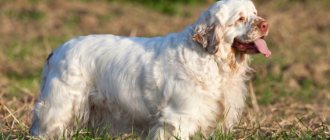Papillons are representatives of continental toy spaniels. A miniature dog with incredible grace and beauty makes you fall in love at first sight.
Fluffy ears reminiscent of butterfly wings attract the gaze of passers-by, and the Papillon's friendly nature and high intelligence make it an ideal pet.
If you don't know what breed of dog to buy, we advise you to pay attention to Papillons.
Basic moments
The name of the Papillon breed means “butterfly” in French. The resemblance to an insect is given by fluffy ears that resemble wings.
Interest in this breed appeared in France in the 14th century. And several centuries later, the popularity of Papillons knew no bounds. Noble people appreciated the compact size of the dogs and their extraordinary appearance.
King Henry III of France was so passionate about these dogs that he spent a third of his treasury on purchasing and maintaining the breed.
The image of Marie Antoinette is inextricably linked with papillons. In many paintings the queen is depicted with her beloved pets.
Papillons are intelligent and sociable dogs that always want to be the center of attention. The owner will not be bored, because these pets have incredible energy.
Breeders recommend this breed for active people. These dogs need to be played with a lot and given long walks.
The good-natured four-legged companion, despite his cuteness and compactness, is always ready to rush to the defense of his owner and family members. These dogs are very smart and can learn many tricks. Training gives Papillons incredible pleasure.
It is worth noting that representatives of this breed get along well under the same roof with cats. There is also no need to worry about the children; the pet will become the baby’s best caring friend.
Features of character and behavior
One of the most important characteristics of the French Papillon is its constant smiling expression. The dog is very cheerful and playful, loves attention and quickly makes friends not only with other pets, but also with people. These pets are never in a bad mood, otherwise this indicates serious health problems.
Papillons are very smart and inquisitive pets. During walks, they will pay attention to every detail, even the smallest. They can rightfully be awarded the title of the best detective dogs among all breeds.
These little pets are very vulnerable, so you shouldn’t raise your voice at them or offend them. You should especially not use physical force against fragile and cheerful Papillons. The dog, despite its active, playful disposition, is quite obedient and will not make noise for no reason.
Butterfly dogs can be left alone in a house or apartment for a couple of hours without any problems; they will not cause mayhem in it.
Note! Papillons require increased attention, so it is worth placing another animal of the same size, such as a terrier, next to the dog.
Breed characteristics
Papillons are classified as small decorative dog breeds. A distinctive feature is the wide-set fluffy ears covered with hanging hair.
In America, the breed is divided into Papillons and Phalenes with low ears. However, in Europe such a division has been refuted, and Phalenes are considered a separate breed.
The breed standards have the following description:
Papillons are miniature dogs. The height at the withers does not exceed 28 centimeters, and the weight ranges from 2.5 to 5 kilograms.
The coat is quite short in the area of the muzzle and the front of the paws.
The dog's body, back of the paws and tail have long, slightly wavy hair.
Characteristics of the breed's physique:
The Papillon is a dog with an elongated rectangular body and a high-set tail. Legs are straight and of medium length. The dog's head is small in size with the tip of the muzzle slightly extended forward.
According to its purpose, the breed is a companion dog. Easy-going pets are ready to support any idea of the owner, and their compact size allows you to take Papillons with you on trips, shops, and public transport.
Papillons have no health problems, with the exception of individual individuals. However, due to their size, the dogs are quite fragile and require careful handling.
Mating
Papillons are not rare, but they are quite expensive dogs. Mating can be carried out at home, but if the bitch is a breeder and has a pedigree, then you need to contact the nursery to obtain a certificate. You need to look for a male dog in advance and agree on a date with the owner. The boy should not be larger in size than the female to avoid complications during childbirth.
Puppies become sexually mature early (8-10 months). Usually at this time the first signs appear: estrus in females and attempts to mount in males. It is recommended to untie only at 20-25 months , when the dogs are old enough to conceive and bear healthy offspring. Then the bitch will be in her third heat, the most favorable days are 13-15 from the beginning of the cycle.
The girl is brought to a male dog, or the dogs are brought together on neutral territory. You can walk your pets together to give them time to get to know each other and play. If the female is satisfied with everything, she will allow the cage to be made. Otherwise, you can try again every other day or choose another male. Sexual intercourse does not last longer than 5-10 minutes . At this time, the girl is supported by the head and under the stomach, and the boy is directed into the noose. If a lock has formed, the pets can be turned with their tails facing each other so as not to injure the genitals.
After mating, the male dog needs to be fed well and the girl needs to be calmed down. The next meeting should take place in 2 days. The progress of pregnancy can be checked at a veterinary clinic.
History of the Papillon breed
It is traditionally believed that the breed appeared in France in the 14th century. However, it is known that back in the 11th century, Duke Godfrey, during the crusade, brought to Jerusalem a decorative dog with ears resembling butterfly wings.
Also, some 12th-century paintings depicted miniature dogs with the fluffy ears characteristic of Papillons.
Papillons can be seen in many paintings from the Middle Ages.
The famous 16th century artist Titian painted paintings featuring small dogs similar in appearance to phalenas. Over the next centuries, painters from various European countries continued to depict them next to rich people.
Due to the love of the rich and kings for this breed, a certain stereotype has developed about Papillons. It was believed that the dogs were bred to entertain nobles.
But it is not so. Ancient healers believed that Papillons were able to heal many diseases with their presence. In addition, these cute dogs were used to distract parasites from humans, and also as heating pads.
At the end of the 19th century, Papillons appeared in America, and at the beginning of the 20th century, the breed became interested in Great Britain.
It was at this time that European breeders decided to cross continental toy spaniels with Spitz dogs. This allowed Papillons to have a lush coat.
After mating these breeds, the position of the tail also changed. In modern Papillons it is located on the upper back.
Interesting fact
Papillons were recognized as an official breed in 1923 by the English Kennel Club, and in 1935 by the American Spaniel Club.
Continental Toy Spaniel, Papillon: nutrition for a small dog breed - what to feed?
Papillon
Healthy nutrition of a small breed of dog is an integral part of the lifestyle of each animal in view of the possible various inherited diseases. Veterinarians advise adopting a puppy only after consultation and examination by an experienced specialist. It was said above that this breed has a number of predispositions. It has thin bones that can easily break if the pet is not handled and fed correctly.
Worth knowing: The Papillon must be fed strictly at a certain time, with special food. At an early age, a continental toy spaniel puppy should be fed with special vitamins for its rapid growth and proper formation.
What to feed:
- The puppy is prohibited from eating various common human foods, namely: sweets, chicken, pork, which can cause severe allergies. It is also not recommended to give bones, as this clogs the intestines.
- Buy food for toy spaniels in special pet stores. This food contains all the necessary microelements and vitamins.
Due to poor nutrition, not only allergic reactions are possible, but also various dermatitis. This type of breed is prone to overeating, so owners must strictly observe the amount of food.
Remember: Papillons are very active and need constant drinking. Clean water should always be freely available to your pet, especially on hot days.
Every Toy Spaniel owner should know the following:
- You can make an exception and give your dog some raw meat. However, there is a risk of infection with parasites, so veterinarians recommend taking special anti-parasitic medications at strictly defined times.
- Important indicators of poor nutrition are watery eyes and a dull coat. This means that the selected food is unbalanced and consultation with an experienced veterinarian is necessary.
Follow the necessary rules in a balanced diet. If you feed your Papillon correctly from the first days of his life, he will give you a lot of pleasure and positivity when interacting with him.
Papillon appearance
Externally, butterfly dogs resemble a plush toy. Fluffy fur coat, raised ears, round big eyes, slightly open mouth and a smile.
It is the appearance of Papillons that leaves no one indifferent.
Sometimes Papillons are confused with Spitz dogs or long-haired Chihuahuas.
Head
Papillons have a small head, proportional to the body. The frontal line is rounded and clearly defined. The tip of the muzzle is slightly pointed.
Nose
The bridge of the nose is straight, slightly flattened on top. According to the breed standard, the nose must be fully pigmented.
Teeth and jaws
The teeth are sharp and strong, with a noticeable scissor bite. The lips are thin and tightly fitting to the teeth. The dog's closed jaw should completely cover the tongue.
Eyes
Papillons have large, almond-shaped eyes.
The color of the iris is dark, the eyelids are fully pigmented.
Ears
The ears are triangular in shape with a rounded tip and set high. The ear cartilage is thin, but capable of holding the ears in an erect position. Long hair hangs down on the outer edge of the ears, giving Papillons a butterfly-like outline of their head.
When calm, the Papillon's ears are raised and the inside remains open.
Phalenes also have high-set ears, but droop down.
Interesting
Due to the appearance of their ears, Papillons are compared to butterflies, and Phalenes to moths.
All Papillons are born with drooping ears. They assume a standing position in puppies up to 4 months of age.
Neck
The dog's neck is of medium length with a slight bend in the occipital region. The neck muscles are dry. The head is set high.
Frame
It has a straight rectangular shape with a slight protrusion in the lumbar area. The chest is wide, the stomach and groin are toned.
Limbs
The dog's paws are thin, smooth and elongated. The shoulders are pressed tightly to the body. The fingers have hard, hard pads and black nails.
Individuals with a dominant white color are characterized by milky claws.
Tail
The tail is located high, close to the tailbone. Covered with long hair with a dewlap that can reach a length of 15 centimeters.
Wool
There is practically no undercoat. The coat is slightly wavy and not too soft. The fur on the muzzle, metatarsus and outer paws is short. On the body the hair is noticeably longer. There are flowing feathers on the ears, tail and back of the paws. The breed is also characterized by a fluffy collar and so-called panties on the hind legs.
Color
The main rule for matching the color to the standard is the presence of at least two shades of coat. Main colors:
- white-sable
- white-red
- White black
- tricolor
With bicolor colors everything is clear. White-sable color implies the presence of two colors on one hair. For example, one hair may be red at the root and black at the tip.
The tricolor color is divided in turn into:
- classic (white and black with tan marks around the eyes, ears and cheeks)
- hound (sable color on the head and spots of black or red color on the body)
According to the FCI standard, white should be the dominant color of the body of the Papillon dog breed.
Disadvantages and defects of the breed
Among the basic deviations from the breed standard are:
- dark color of face and paws
- white ear color
- plain color
- weak pigmentation of the nose
- malocclusion
- donut tail
- clubfoot
- convex or concave muzzle shape
Dogs with such defects are not allowed to show and do not have permission to breed.
Papillon colors
Traditionally, the Papillon's coat is white with spots of various colors - red, black, pale lemon, chestnut. Mottling is allowed, but in appearance it does not always decorate the dog.
The most popular Papillon colors are:
- sable (white-sable) – the hair has red and black colors, most often “sable” is found on the ears (along the ear linen the red color turns into a black edging);
- tricolor (three-color) - the most controversial color option;
- bicolor – red and white and black and white;
- hound tricolor - “sable” on the head, one or more black spots on the body.
This is interesting! The dog's color changes as it grows. The true color appears by six months, but may change throughout life.
Photo of Papillon
The photographs show papillons that meet breed standards.
Papillon character
Papillons are distinguished not only by their cute appearance, but also by their ideal character. Very gentle dogs, they almost never behave aggressively with other animals or with children. They are sociable, energetic and easily adapt to any new conditions.
The furry four-legged friend is ready to accompany the owner always and everywhere; he can be carried in his arms or led on a leash. Regardless of age, Papillons love fun and games. Their positivity is greatly appreciated by dog lovers.
Papillons have a very inquisitive nature. They are interested in everything and everyone around them. A new toy will captivate the dog for a long time, and a walk will become an adventure with exploration of the surrounding area.
General information
It is almost impossible to train, because genetically, by nature, the breed cannot act as a protector of its owner. However, this animal is incredibly brave and purposeful. And if people close to her are in danger, the dog will immediately come to the defense of her family. The dog can bark loudly and furiously, but until the owner gives a sign to stop (this is provided that it is trained). But why not forgive small flaws in her behavior for her unusually pretty appearance? She is sweet and gentle, like a cat.
Training and education
Papillons, like any other dog, should be trained in puppyhood. It is important for the owner and other family members to understand that any indulgences spoil the dog’s behavior. To get an obedient, socialized dog, you need to stop unwanted behavior and, on the contrary, encourage the execution of commands.
At the age of 6 months, with proper training, a Papillon puppy already understands that nothing can be picked up from the ground, reacts adequately to crowds of people and follows a basic set of commands.
From an early age, it is advisable not to allow the pet to sleep on the bed with the owner. The dog should have its own place to rest. In addition, a puppy should not be trained to beg for food from a human table. Human food is harmful to a dog's health. The breed is also prone to developing obesity.
Papillons, despite their cuteness, immediately sense the weakness of their owner’s character and can begin to manipulate him. Therefore, owners are not recommended to make concessions to their four-legged friend.
The best way to train a Papillon is through play. You can get by with regular training, since dogs are incredibly smart and capable of many things, but it is the game that will bring pleasure to the pet and allow it to spend energy wisely.
It is recommended to give commands in a calm but firm tone. The dog must understand who is boss in the house, but at the same time it should not be afraid of its owner.
Attention!
Under no circumstances should you shout at your pet, much less hit it.
Such actions can harm the animal’s psyche and sometimes lead to retaliatory aggression. The best training techniques are affection, encouragement and play.
If the owner has an adult, untrained Papillon, then it is better to entrust his training to dog handlers.
Papillons are capable of remembering a lot of information, which opens up many training possibilities with these dogs.
You can unleash the potential of Papillons in agility, freestyle and other types of dog sports.
Always think before taking on such responsibility!
Inna: “When it comes to inventing thousands of ways to attract attention, my favorite Papillons are simply experts. They take advantage of my gentleness and kindness to get their way. Sometimes it feels like they are testing how trusting I am.
Valery: “Thanks to their small size, these dogs are tireless on walks, run quickly, and do not get tired at all. The Papillon can run many kilometers and loves to travel. Papillons love to splash in the water.”
Rina: “I have seen a lot of dogs in my life. Finally it was Papillon's turn. Having come to our house by chance, he remained there forever.”
Interesting facts about Papillons
- The Papillon dog breed is included in the top ten ranking of the smartest dogs.
- Once you get a Papillon, you won't be able to choose another breed.
- Representatives of this breed are capable of experiencing emotions inherent in humans. Among them: jealousy, love, resentment, joy. Each state of a dog can be easily counted by its face.
- Papillons are incredibly loyal to their owner. Marie Antoinette's dog, named Coco, accompanied the queen until her death, running out to her owner's execution.
- Papillons understand human speech well.
- After the revolution in France, Papillons were killed because they were associated with the bourgeoisie.
Care and maintenance
Before purchasing a purebred puppy, it is advisable to prepare in advance the necessary items for entertaining, maintaining and caring for dogs.
Recommended purchase:
- place to relax. This could be a comfortable basket with a mattress, a sofa with interchangeable ottomans, or a cage. Cages are more suitable for large breeds, but sometimes they are really convenient and irreplaceable.
- Bowls for water and food. Metal and ceramic dishes are perfect for these purposes.
- Comb or comb. The accessory is necessary for caring for the hair of Papillons.
- Leather collar and leash. For decorative dog breeds, you can use a tape measure. It is not recommended to buy harnesses, as they can harm the dog.
- Toys. These can be various balls, dumbbells, etc. It is advisable that the toys be latex.
Caring for the appearance of Papillons is not too difficult. With sufficient walking, Papillons' claws do not require additional care. In other cases, it is recommended to trim them after bathing with special dog clippers.
Hygiene
The procedure for bathing butterfly dogs should be carried out as they become dirty. It is better to dry wool with a hairdryer. This will allow the hairs to avoid tangling and curling.
Special toothpastes and denta-bones are perfect for cleaning teeth.
Dogs' ears should also be kept in order. Children's cotton swabs with a thin tip are perfect for this.
Toilet
Papillons can be trained to use a litter tray or disposable diapers. But, since these dogs need a long walk, Papillons must go to the toilet outside.
It is better to toilet train your puppy right away. First you need to explain to him that he should go to the toilet using diapers or newspapers. To train to the litter box, breeders advise placing a piece of used diaper in a clean litter box and introducing the dog to the new toilet. It is believed that the dog will quickly understand what needs to be done by the smell of the diaper.
If the dog is going to relieve itself in the house, the owner does not need to scold it; it is better to take the Papillon to the toilet or outside.
Feeding
The Papillon's diet consists of natural food or dry food.
When feeding dogs natural food, you need to take into account some characteristics of the breed.
Attention Chicken meat often causes allergies in Papillons, so it is recommended to exclude this product from the diet.
It is better to use lean meat as a source of protein. However, it is also not recommended to give meat raw, since the dog can catch an infection or parasites. Before feeding, it is better to boil and chop this product a little.
Due to their fragile skeleton, Papillons require calcium. Your diet should include bone chalk or seaweed.
Healthy food:
- porridge
- sea fish fillet
- offal
- fruits and stewed vegetables
- lean meat
Junk food:
- potato
- chicken
- fat meat
- sweet and starchy foods
- tubular bones
- chocolate
When choosing to feed dry food, you should give preference to super premium food that does not contain grains or chicken.
When buying a puppy, it is better to ask the breeder what the baby is used to eating. A sudden transition to a new type of food or feed can trigger allergies and digestive problems.
Up to two months of age, it is recommended to feed puppies 6 times a day, gradually reducing meals. By the age of one year, Papillons should be fed twice a day.
Shedding
Due to the lack of undercoat, shedding does not cause problems for owners of this breed. However, during this period, the dog should be brushed every day. The rest of the time it is recommended to do this twice a week. It is important to pre-moisten the Papillon's coat before combing; without this procedure, the hairs will become brittle and dull.
In the warm season, caring for Papillon hair involves trimming the body, as well as the inguinal and anal areas. For the aesthetic appearance of dogs, it is better to turn to professional groomers for these procedures.
Attitude towards children and others
The Papillon's positivity and energy will allow him to easily make friends with children. A dog that is ready to play always and everywhere will appeal to any child.
When communicating between a dog and a baby, owners should always be nearby. Young children often do not understand that they can hurt an animal. Despite the lack of aggression, the pain caused can provoke the pet to bite. In addition, Papillons are very fragile dogs; careless play can cause serious harm to their health.
Papillons treat others calmly and adequately. However, sometimes the pet is not too happy about guests. The fact is that the Papillon is comfortable being with his family, and he does not need strangers. In addition, guests attract the attention of the owner, and Papillons begin to be jealous.
Is it suitable for family
Reviews from Papillon owners indicate that this breed is ideal for a family . Four-legged companions love to play with children, bring them balls, sticks, and follow commands. Some representatives of the breed even guard the stroller with the baby.
Attitude towards other animals
Papillons get along well not only with children, but also with other animals. They have a special love for cats. Papillons are believed to be the only dog breed with a cat-like outlook. Perhaps that is why they get along so well with each other.
Aggressiveness
With timely and proper training, Papillons will never show aggression.
In cases where no one has cared for the dog or has abused it, the Papillon, like any other animal, can become unbalanced and aggressive.
Intelligence
Papillons have very high intelligence. It is not for nothing that the breed is in 8th place in the top ten smartest dogs in the world . They easily learn new skills, understand human speech and feel the owner’s emotions.
How to cope with loneliness
French decorative dogs do not like to be alone. Unlike other breeds, they will not damage furniture, but a long absence of the owner can provoke depression in them.
Attention
Papillons are not recommended for single people with a strict work schedule.
To make it easier for the dog to endure the absence of its owner, breeders recommend getting the Papillon a friend, for example, a cat.
Feeding
A balanced diet is an important condition for maintaining health. If the menu is compiled correctly, the dog is playful, and its coat does not lose its natural shine. Feeding bulky, low-calorie diets is unacceptable; this will lead to changes in the development of the skeleton, internal organs, and disturbances in the exterior of the growing dog. Food that is too high in calories will cause obesity and your pet will look too massive.
The diet should include food of animal and plant origin. What to feed:
- meat (beef, veal, rabbit) – raw, scalded with boiling water;
- boiled offal (liver, kidneys, udder, heart, lungs);
- porridge (buckwheat, oatmeal, rice, corn);
- fermented milk drinks and products;
- sea fish (boil, remove bones) – 1 rub./week;
- egg yolk - 1 rub./week;
- raw vegetables and fruits (finely chopped).
Food must be fresh. Unrefined vegetable oil will be useful; it is given in 0.5 table doses. l. per day, several days in a row. Such courses are conducted 2-3 rubles/year.
Papillons have fragile bones, so your pet needs to be fed foods rich in calcium. The puppy is given milk, diluted with water in a 1:1 ratio. It is recommended to add bone meal, milk powder, seaweed powder, and chalk to the main food. Once a week you can give a sugar pit (fresh).
How many times a day to feed:
- 1.5-3 months. - 6-8 rubles;
- 4-5 months - 4-5 rubles;
- 6-9 months - 3-4 rubles;
- 9-12 months – 2-3 r.
- from 1 year - 2 rubles.
You cannot give food from the table, it contains too much fat, salt, and spices. Other prohibited products:
- tubular bones;
- fried, smoked;
- sausages;
- potatoes, legumes;
- cheese;
- pork;
- chocolate, sweets;
- River fish;
- flour.
Do not overfeed your dog, this will have a negative impact on health. If the puppy eats with great appetite and is clearly overeating, you need to strictly dose the food. Give food at the same time, then wash and put away the bowl. Don't distract your dog while eating. You should not go for a walk immediately after feeding; take your pet for a walk 30 minutes after he has eaten.
Reproduction and lifespan
Many owners are interested in how many years Papillons live.
Their average lifespan is 12-15 years. If a dog eats well, lives in comfortable conditions and has no diseases, it can live up to 20 years .
The dog's body type also affects its lifespan; an obese animal lives much shorter. Therefore, owners should monitor not only the health of the Papillon, but also its weight.
Papillons' first heat occurs at 6-12 months, but they become ready for mating at the age of two years. Reproduction at an earlier age has a negative impact on the dog’s psyche and the health of the offspring.
Preparation for mating begins with choosing a partner. The pedigree of dogs will help eliminate inbreeding (close family ties). You should also pay attention to the health of the future partner and assess the balance of the psyche. If the dog has noticeable allergies or other diseases, and there is also aggressive behavior, then it is better to cancel the mating. The risk of transmitting diseases and aggressive behavior to future offspring is very high.
After choosing a partner and discussing the details with its owner, it is recommended to carry out routine vaccination and deworming of the dog.
During pregnancy, any medications and vaccines are contraindicated.
It is recommended to start the mating process between 9 and 15 days from the start of estrus. To guarantee pregnancy, Papillons should have several matings. It is better to cover the female in the territory of the male, so that he does not experience stress and feels confident.
The Papillon girl also needs to feel calm, so the day before the planned mating you can introduce the future couple.
Pregnancy in this breed usually proceeds normally. The duration of pregnancy for Papillons is usually 58-63 days, in some cases it can last up to 71 days.
A pregnant female needs special care. It is important for owners to monitor a balanced diet, emotional and physical calm of the dog. It is not recommended to pick up the animal and allow it to become overtired. The number of feedings in the second half of pregnancy should be increased.
Before giving birth, the owner needs to prepare the birthing area and trim the hair in the abdomen and genital area. There are cases where puppies get tangled in their mother's long fur, which leads to suffocation and death of the baby.
You can tell that a dog is giving birth by the following characteristic signs:
- restlessness and rapid breathing
- cardiopalmus
- decrease in body temperature
- refusal to eat
- extreme thirst
- contractions
- discharge of amniotic fluid
Labor in Papillons normally lasts for 3-12 hours.
The number of puppies for Papillons depends on the age of the dog and individual characteristics. On average, a female gives birth to 2-6 puppies.
Causes of premature death of a dog
Accidents, poisoning, and existing pathologies of internal organs lead to the sudden death of animals. Negative consequences are difficult to predict, however, it is preferable to know what potential dangers threaten your pet.
Common causes of premature canine death:
- poisoning;
- heart disease;
- pneumothorax;
- tracheal collapse;
- congenital abnormalities;
- expansion, volvulus of the stomach;
- ulcer;
- splenic tumor rupture;
- foreign body entering the throat;
- heatstroke;
- injury.
Dogs often suffer from poisons intended for rodents, poisons distributed to exterminate stray dogs. During a walk, be sure to keep an eye on your pet; if the dog does not respond to the command “ugh,” put on a closed muzzle so that the dog does not try questionable “food.”
Heart diseases can manifest asymptomatically, but if a young dog gets tired quickly, is weak, or is breathing heavily, you need to visit a veterinarian for a diagnostic examination.
Air accumulation in the peripulmonary space (pneumothorax) occurs due to injuries to the sternum leading to damage to the emphysematous bladder or existing tumor on the lung.
Tracheal collapse is more common in small breeds, is expressed by a sharp cough after active mobility or the manifestation of strong emotions, and sometimes occurs as a complication of past infections.
A congenital pathology that leads to tragic consequences is the displacement of the cervical vertebrae as a result of insufficient development or defect of the ligaments. An accidental jolt to the problem area can cause pressure on the spinal cord and be fatal.
Gastric dilatation and volvulus are more common in older dogs; both pathologies interfere with the normal blood supply to other organs and are considered deadly. Prevention of stomach problems is considered to be proper nutrition, adherence to a feeding regime and moderate exercise.
The premature death of the animal is caused by complications of peptic ulcer disease, expressed in the formation of a through hole in the wall of the stomach or bleeding. A precaution is the proper nutrition of your pet.
New growths on the spleen (benign and malignant) are susceptible to rupture, which can lead to fatal loss of blood. Tumor rupture is possible even with minor damage caused by difficult bowel movements or increased physical activity.
Swallowing a foreign object risks suffocation or injury to internal organs as the swallowed object moves inside.
Heatstroke is caused by severe overheating of the body and often occurs in dogs locked in a car in hot weather.
A dog can be injured on the street (being hit by a car, fighting with other dogs, etc.), at home (falling from a height, electric shock, etc.), the danger of injury depends on the degree of its severity and the provision of first aid.
Papillon Health and Diseases
Papillons are in good health, but some representatives of the breed may have the following hereditary diseases:
- Allergy. Dogs with a dominant white coat color often have this disorder.
- Retinal atrophy and cataracts. Dangerous diseases that lead to complete blindness of the dog.
- Urolithiasis disease. The cause is a violation of the excretion of salts from the kidneys.
- Poor blood clotting. Manifested by bleeding.
- Degenerative myelopathy (immobilization of the hind limbs). The disease most often occurs in adult dogs.
- Deafness. A very common congenital disease in Papillons.
- Representatives of the breed may also suffer from reverse cough and entropion.
Don't forget about infectious diseases. To prevent your pet from picking up an infection, it is very important to comply with routine vaccinations . In addition, the dog needs parasite prevention, as well as flea and tick treatment. A large number of four-legged pets die from the bite of an infectious tick.
Each vaccination, deworming and treatment against ticks and fleas must be recorded by a veterinarian in the dog’s passport.
Pros and cons of the breed
| Advantages | Flaws |
| High intelligence | The need to strictly adhere to the feeding diet |
| Pleasant, sociable character | Need for clothes for winter walks |
| Cleanliness | Inability to remain alone for a long time |
| No dog smell | Cases of congenital deafness |
| Love of outdoor games and walks | |
| Gets along well with other pets | |
| Good health |
How to choose a puppy
People who want to get a Papillon puppy often don't know how to choose the right one.
The main proof of a dog's breed is its documents. Therefore, it is recommended to buy a four-legged friend in nurseries or from bona fide breeders.
The puppy must have a puppy card that shows its parents and grandparents. In the future, if desired, the owner can exchange the metric for a pedigree.
Before purchasing, you also need to check for a veterinary passport with vaccinations for the puppies.
In order to choose the right Papillon puppy, it is recommended to pay attention to the following points:
- Activity. The puppy should be cheerful and vigorous, this indicates his good health.
- Appearance. Examine the ears, eyes, front and rear limbs, and tail of the puppy. Also rule out the presence of an allergic rash.
- Reaction. Clap your hands loudly next to the puppy; the presence of a response excludes deafness.
- Parents. Assess the parents' appearance and behavior. Dogs must look well-groomed. There should be no aggression.
The optimal age to buy a puppy is 2-3 months. At this age, the puppies are already vaccinated and ready to be weaned from their mother.
At the age of one and a half months, breeders send babies for the first official examination by a veterinarian. Based on the results of the examination, a conclusion is issued on the absence or presence of birth defects, as well as a decision on admission to breeding. After this procedure, the offspring receives puppy metrics.
Dog health
Papillons are considered long-lived; with proper care, they can live up to 15-17 years. The most common diseases found in dogs are:
- eye diseases (entropion, cataracts, retinal dystrophy);
- dislocation of the kneecap;
- congenital deafness.
Papillons are very sensitive to anesthesia. Be sure to remember this, because it is quite possible that the animal will have to undergo surgery.
To protect your puppy from diseases, you need to vaccinate it in a timely manner. The procedure of worming and the fight against external parasites is mandatory.
Photos of Papillon puppies
The photographs show Papillon puppies at different ages.
How much does a dog cost?
Despite the fact that the breed is common, problems often arise when purchasing a puppy. The thing is that there is usually a small number of babies in a litter.
The average price for a purebred Papillon puppy ranges from 30 to 50 thousand rubles. Only babies with champion parents will cost more. The price for such puppies starts from 70 thousand.
Puppies that have a breeding marriage cost only 10-15 thousand. They are cute, healthy, funny, just not up to standard. If you need a friend, not a future champion, feel free to buy such a puppy.











